 As a chiropractor, pain is something I see in my Los Angeles, Beverly Hills, and West Hollywood chiropractic practice every day. There is no shortage of people in pain—low back pain, neck pain, headaches, TMJ or jaw pain, shoulder pain, knee pain, and whole slew of other painful conditions. With chiropractic care, my clients experience incredible relief from their pain and dysfunction; and with few extra tricks, pain can be managed to such a degree that it may just become a thing of the past. As a chiropractor, pain is something I see in my Los Angeles, Beverly Hills, and West Hollywood chiropractic practice every day. There is no shortage of people in pain—low back pain, neck pain, headaches, TMJ or jaw pain, shoulder pain, knee pain, and whole slew of other painful conditions. With chiropractic care, my clients experience incredible relief from their pain and dysfunction; and with few extra tricks, pain can be managed to such a degree that it may just become a thing of the past.
In addition to being a chiropractor, I am also chiropractic sports physician. Along with that I have been a practicing yogi for the last ten years. Through my training, my yoga practice and my education, I have come to learn the enormous benefits of stretching for health. A regular stretching routine can not only relieve pain, but it can prevent pain from becoming cyclic—that is, from becoming a chronic problem that recurs over and over again.
Subluxation Pain vs. Muscle Pain
Pain can come from many sources. The two most common to chiropractic offices are joint related and muscle related issues. Joint related issues are most often subluxations, which are joints that have become stuck. Stuck joints cause pain, inflammation, muscle spasms, and nerve irritation. There is only one effective way to correct a subluxation, and in turn, remove the excruciating pain that comes along with it—through a chiropractic adjustment. Chiropractic adjustments essentially gap the joint, allowing the synovial fluids to run back in and relubricate the joint, returning normal motion. When normal joint motion returns, pain, inflammation, muscle spasms and nerve irritation all decrease. Bravo—mission accomplished.
But how long does it last? Well, it depends on a lot of factors: flexibility, strength, nutrition, chemical insult, mental stress, and exposure to toxins, to name a few. The only factor I am going to focus on here is flexibility, which comes, in no small part, down to stretching. Stretching is the active lengthening of muscle tissue. It is pulling one end of a muscle from the other. The most basic stretch that everyone knows is bending forward, flexing the hips and touching the toes. This hamstring stretch pull the part of the muscle attached to the buttocks away from the part attached to the back of the knee, allowing lengthening overtime.
But what happens when a muscle loses length? Sounds weird doesn’t it, loses length? How can a muscle lose length? When a muscle isn’t stretched, overtime gravity works on the muscle shortening it, bringing the end points closer together. Have you seen an elderly person hunched forward in a C-shape? That’s gravity at work, and the consequences of un-stretched muscles.
When muscles get short and tight, they can cause pain. The pain of a shortened, tense muscle can be unrelenting achiness, burning and/or feelings of stiffness or tightness. Tight, short muscles also prevent the chiropractic adjustment from holding, so joints tend to subluxate much quicker, adding to the pain and discomfort.
How Chiropractic Can Help Relieve Muscle Pain
Chiropractic is not just useful for stuck joints and the pain that comes along with them. A good chiropractic adjustment, remember, not only restores normal joint motion, but it also reduces muscle spasms. Think about it: If a joint is stuck, causing a significant guarding response (an involuntary protective muscular spasm), then removing the subluxation and returning normal joint motion should make muscles relax, shouldn’t it?
The fact is that as a person receives regular chiropractic care, their muscles start to relax and get more pliable. Muscle spasms diminish and trigger points dissolve away. A good sports chiropractor will help these processes along with effect muscle therapy techniques. But, all in all, regular chiropractic adjustments over a short period within a prescribed treatment plan should do wonders for reducing muscle pain and tension.
How Stretching Helps
When it comes to short, tight muscles, nothing beats stretching to provide pain relief and long-term prevention of discomfort. As I’ve described earlier, stretching is pulling one end of a muscle away from the other end, which overtime brings actual lengthening to the muscle tissue. This free up the joints, for sure, so it allow chiropractic adjustments to hold longer—that is, the joint won’t lock up and become subluxated again too quickly. But as muscle tissue lengthens, tension releases, and that sore, achy feeling that is a part of the tight muscle experience starts to vanish, too.
A regular stretching program brings flexibility and freedom to the body. I tell my clients: fifty percent of the patient visits I see in any given week could be prevented if people just stretched regularly. Now I realize that this is bad practice management, because after all, shouldn’t doctors want more people to come into the office in pain? The answer is no, at least not in my practice. I try to teach people ways to empower themselves physically. I would love for them to come in needing only chiropractic maintenance and wellness care. But as long as people continue to neglect the stretching of their muscles, my Los Angeles, Beverly Hills and West Hollywood chiropractic practice will be in business, treating people in pain—that’s just a fact of life, for now.
A Beginners Stretching Routine
So I’d like to give you a beginners stretching routine to get you started. I realize that it’s important to be practical when discussing frequency of activity, especially with beginners. In a perfect world, you would do these stretches every day; however, I do realize that it might be asking a lot, so I would say doing even as little as three time per week will do wonders for your body and for your life. These stretches need not be performed in any order, but I personally like to do my legs and buttocks first, and then move on to my neck, chest, shoulders and arms.
Here is the beginners’ routine:
- Lying hip stretch
- Muscle stretched: piriformis
- Hold: 30 seconds each side
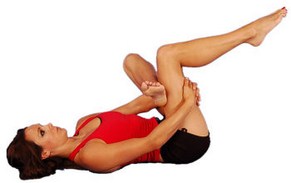
- Standing hamstring stretch
- Muscle stretched: hamstring
- Hold: 30 seconds

- Standing hip flexor lunge
- Muscle stretched: iliopsoas
- Hold: 30 seconds each side

- Chest stretch
- Muscle stretched: pectoralis minor
- Hold: 30 seconds each side

- Lat Stretch
- Muscle stretched: latissimus dorsi
- Hold: 30 seconds each side

- Biceps stretch
- Muscle stretched: biceps and pectoralis major
- Hold: 30 seconds each side
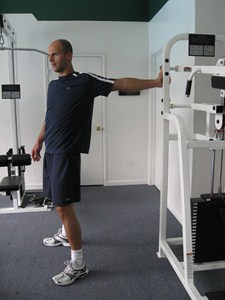
An Advanced Stretching Routine
For you more advanced stretchers—anyone who has taken yoga, played sports or currently stretches at the gym, in dance class or with a trainer—try the following routine. Do the same exercises above, but add:
- Pigeon
- Muscle stretched: piriformis
- Hold: 60 seconds each side

- Thigh stretch
- Muscle stretched: rectus femoris
- Hold: 60 seconds each side

- Neck stretches
- Muscle stretched: upper trapezius, levator scapulae
- Hold: 30 seconds each side

- Shoulder stretches
- Muscle stretched: posterior capsule
- Hold: 30 seconds each side
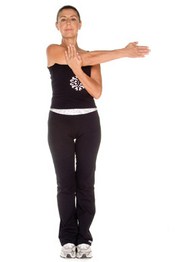
- Forearm stretches
- Muscle stretched: forearm flexors
- Hold: 30 seconds each side
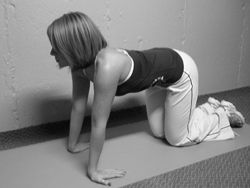
Something that everyone who stretches needs to be aware of is that to actually add length to muscles, the duration one holds the stretch is what really matters. Thirty seconds is the minimum duration necessary to add muscle fibers to the end of stretching muscle. Sixty seconds is even better, but thirty will do. As I point out in my book, The Six Keys to Optimal Health, it’s not how far you stretch a muscle that matters, but how long you hold the stretch. So to gain all the benefits that come along with muscle lengthening—reduced pain, increased freedom of movement, pain prevention—you’ll need to hold that stretch, no matter how uncomfortable it is. Hold it!
There is another type of stretching that one can do, which I call “cobweb stretching”. This should be done in place of regular stretching when time is limited. Cobweb stretching is holding a stretch for a shorter time than usual—ten seconds, for example. This way, even if you are short on time, you can go through your entire routine and “get the cobwebs out.” Now before you think there is little benefit to this type of stretching, understand that holding a stretch for even a few seconds will open up the muscles giving you freedom of movement. Cobweb stretching is a regular part of my busy schedule, and it serves me well. I highly recommend it for anyone wanting to maintain muscle flexibility and a pain-free life.
What You Can Expect From Stretching
Taking on a new stretching regimen comes along with predictable results. The very first thing beginners experience is the discomfort of stretching tight, neglected muscles. For some the discomfort just feels like tightness, yet for others there might be a burning sensation. Fret not, this is normal. When you feel burning, it is lactic acid being released by the muscle tissue. Nevertheless, you do not want to go too far into the stretch when you feel the lactic acid burn, so go easy. If you have never felt this sensation before, don’t be afraid; the burn I am talking about is nothing more than an “Indian burn,” the kind we used to give each other as children.
The discomfort of the initial stage of stretching will pass rather quickly, and then the stretch will start to feel good. Interestingly, it is the same sensation you have been feeling all along, but the mind starts to process it differently; in other words, perception shifts. It is really amazing how this happens, but I know from ten years experience, the pain of stretching never goes away. On the contrary, I now crave it, and stretch every moment I can. Weird but true.
As I’ve said in past articles, many things can cause pain, and it is advisable to see a doctor if you are experiencing pain that lasts for more than one week. Pain that is positional, or is set off, or increased by movement, or is easy to localize, and hurts worse when you push into it, then it is likely musculoskeletal pain. Obviously, there are exceptions to these rules, but nevertheless you should get these issues checked out by a doctor, preferably a sports chiropractor. Here’s why: A sports chiropractor is a doctor, so he or she can diagnose your problem. But whereas a medical doctor can also diagnose your problem, he or she will likely have to send you off to a physical therapist’s facility to be treated. Not so at a chiropractic office. Chiropractors diagnose the problem, and they treat the person in pain right there at the office. Nothing like getting all-in-one service, now is there? Another benefit of seeing a chiropractor is that they are trained to detect non-chiropractic disorders, and so they will send you to the appropriate practitioner if yours is not a chiropractic case. So, regardless of whether your problem is musculoskeletal in origin or organic, a chiropractic office is a good place for you to start. If you are having a musculoskeletal problem, and you live in the Los Angeles, Beverly Hills or West Hollywood regions, come visit my sports chiropractic office. I will provide you with top-quality chiropractic care and a stretching routine that will be sure to make your low back pain, neck pain, hip pain, and any other musculoskeletal pain problem a thing of the past.
-October 5, 2009

*NOW AVAILABLE
The Six Keys to Optimal Health by Dr. Nicolas Campos
For More Advice on Health and Optimal Living Read
The Six Keys to Optimal Health by Dr. Nicolas Campos
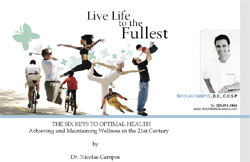
|

















